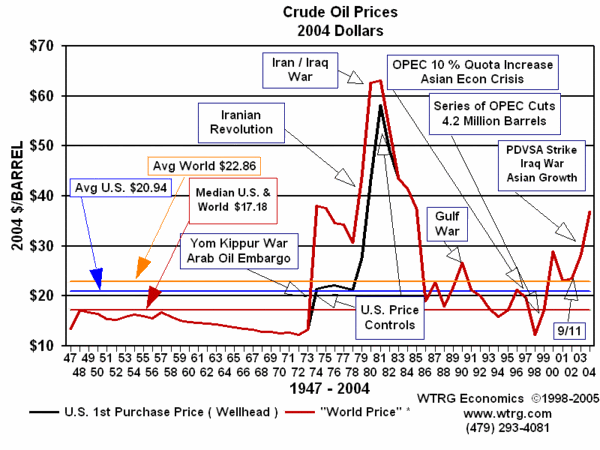Wednesday, May 31, 2006
Less is more
Tomorrow begins the meeting of OPEC ministers in Caracas Venezuela. While this meeting will probably be uneventful this is a good time to take a look back at how Venezuelan President Hugo Chavez helped revitalize OPEC and turn less oil into more money. This concept of less oil often equals more money is generally lost on the Venezuelan opposition who have their own reasons for wanting to maximize production. But it is not lost on those who monitor the global oil industry as shown by this article from 2000 in Oil Monthly. Their overview of what the trends were in the oil industry at that time give an insiteful account of how Chavez changed both Venezuela and OPEC. Here are some exertpts:
Seems like a pretty clear demonstration of the utility of restraining oil production as prices went from about $12 per barrel to $30 per barrel in one year as this chart shows:

And even the Norwegians can see the benefit of restraining production and reaping more revenue. To bad none of the candidates running against Chavez this year can. Some people never learn.
|
Less becomes more for OPEC - Organization of Petroleum Exporting Countries - Industry Overview
Although many analysts and industry skeptics never thought it would happen, OPEC finally managed to make one of its quota agreements stick. In the process, the group also achieved a significant reduction in global oil production. In March 1999, OPEC members (exclusive of Iraq) agreed to cut an additional 1.7 million bopd on top of two earlier accords reached in 1998. Now, nearly a year later, the agreement is still in effect, and OPEC has achieved its goal of raising oil prices significantly. Some observers would say that they have succeeded too well, as prices were hovering near $30/bbl as this article went to press.
.............................
Mexico. A three-year escalation of crude and condensate production came to an end last year. Output averaged 3.01 million bopd, down 5% from 1998's figure. The decline can be traced to Mexico's informal agreement with OPEC for mutual reductions in oil output, to shore up crude prices.
..............................
Venezuela. The days of Venezuelan quota-busting are gone. President Hugo Chavez and his appointees at the Ministry of Mines & Energy, and state firm PDVSA, have adhered fastidiously to OPEC quota reductions that have revived oil prices. As a result, the country's oil production fell nearly 12% in 1999, averaging 2.78 million bpd.
.............................
Norway. After cutting oil production by 100,000 bpd during 1998 and early 1999, Norwegian officials reduced output another 100,000 bpd to help prop up prices. As a result, Norwegian crude and condensate production declined 2%, to 3.04 million bpd. Statoil operated roughly 40% of all output. The government indicated that it would stick with the 200,000-bopd reduction through the first quarter of 2000.
...........................
After two consecutive years of significant increases, Middle Eastern oil production declined 2.30, to 20.878 million bpd. The decrease can be traced to OPEC's agreement to lower output, in an effort to raise oil prices. Most countries reduced production, although Iraq added more than 500,000 bopd as part of its United Nations-approved "oil for food" sales.
Seems like a pretty clear demonstration of the utility of restraining oil production as prices went from about $12 per barrel to $30 per barrel in one year as this chart shows:

And even the Norwegians can see the benefit of restraining production and reaping more revenue. To bad none of the candidates running against Chavez this year can. Some people never learn.
|
